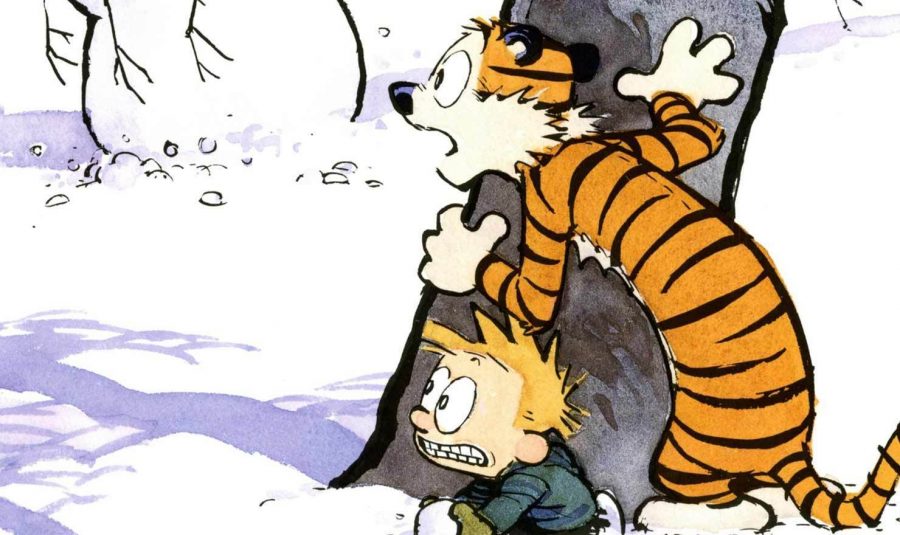Do you realize it has been over twenty years since the last of the great American comic strips were introduced to the world? Following over 60 years in which it seemed as if a classic comic strip was introduced every ten years or so, the dry run ended with the almost simultaneous rise and resignations of Bloom County, Calvin and Hobbes and The Far Side. Since their demise…nothing. Unquestionably, this dearth has little to do with lack of imagination. Several factors have combined to remove quality from the funnies pages of American newspapers. One of those is the utter lack of respect shown comic strip creators by the newspaper conglomerates. In the golden age of comic strips, these glorious little snatches of Americana received the full treatment of respect awarded to advertising for toilet paper today. Comic strips were actually large enough to read and allow the artists to create wondrous worlds. Today’s little one inch square panels are an embarrassment. No wonder that any artist worth his salt has eschewed the limitations of newspaper management for the wide-open vistas of the internet. The internet is the place where you will find the next great comic strip, trust me.
And so, having written a eulogy for the newspaper comic strip, allow me to list one man’s opinion of the ten greatest newspaper-based comic strips of all time. I tried to limit this list to those comic strips that are best known in that medium. Many comic books have been translated into strips and many strips have found more success as cartoons, either as short subjects preceding movies or on television. In addition, I’ve also limited the list to those comic strips that are considered mainstream. While Matt Groening’s Life in Hell is certain a fantastic comic strip deserving of a place in the top ten, it remains an alternative strip. The comics on this list all rose to prominence in daily newspapers across the country. May they not rest in peace, but find new life in spectacularly-designed reruns on the internet.
10. B.C.
A bit more subversive than it might appear to the casual viewer. Later this list will include some strips commonly assumed-rightfully, though not to the extent some would argue-to have liberal biases. The creator of B.C. openly acknowledges that he uses his strip to further his fundamentalist Christian worldview. Why B.C. is on the list is that all of this probably comes as a surprise to a great many readers. B.C. doesn’t try to beat its readers over the head with conservative dogma in an unfunny way as does, for instance, Mallard Fillmore. Admittedly, there have been the occasional provocative B.C. strips that have resulted in censorship and outrage, and I do join the chorus of those who say they may be inappropriate for the Sunday funnies, but to attack Johnny Hart’s right to draw them or the newspaper’s right to publish them is to be no different from Muslim demonstrators rioting over cartoons depicting Muhammad. The plain fact of the matter is that, aside from the occasional misstep in the arena of religious sensitivity, B.C. regularly offers up food for thought that could easily get Hart accused of liberal sentiments, especially the regular indictments of the influence of consumerism, and the profits-over-all mindset of the corporate world.
9. The Far Side.
Gary Larson. Okay, let’s admit it, there is probably no one in the world who ever “got” every single Far Side cartoon except Gary Larson. And, frankly, I’m not even sure about him. Sometimes I think he just drew something to see what people would read into it. Which, come to think of it, is not a bad idea for a comic strip. Some of Larson’s ideas are immediately understandable and don’t suffer because of that. Others take some time to fully appreciate. And more than a few just never seem to gel. The Far Side at its best and worst, however, serve to remind us just how incomprehensible and ridiculous this world really is at its core. The Far Side works best as a guide to helping those who misunderstand the concept of true irony; if you are one of those who persist in confusing unpleasant coincidence with irony, take a few minutes to flip through one of the Far Side galleries and soon enough things will get cleared up for you.
8. Pogo.
Kind of the Doonesbury or Bloom County of the 1950s and 1960s, this was political satire as its best. Pogo probably featured the most extensive collection of characters to ever populate a comic strip, or any twentieth-century media for that matter. Creator Walt Kelly would introduce new characters as the occasion arose and felt no compunction at all about sending them away for good once they had served their purpose. (Just one of the influences of Pogo that can be felt in The Simpsons.) If ever anyone deserved the mantle of inheritor of Mark Twain, it was Kelly. Pogo took no prisoners; he even had the guts to challenge psychotic Senator Joseph McCarthy at the height of McCarthy’s power to ruin reputations and destroy lives. So controversial was Pogo that when he was about to run a particularly controversial storyline, Kelly would offer newspapers an alternative collection known as the Bunny Strips, which invariably featured inoffensive jokes featuring his most adorable characters. Almost certainly the episode of the Simpsons in which Marge’s complaints about the violence of Itchy amp; Scratchy cartoons results in the creation of a cartoon in which the cat and mouse politely enjoy a glass of lemonade was inspired by this bizarre footnote in the history of comic strips.
7. Krazy Kat.
Probably the least well-known strip on the list, and also just as likely the most influential, with the possible exception of Peanuts. Krazy Kat tells the story of Krazy Kat, who is love with Ignatz Mouse who hates Krazy and conspires to throw a brick at him/her and Offisa Pup who, in love with Krazy, tries to both protect him/her and to arrest Ignatz. And that, in a nutshell, is the plot of the average Krazy Kat strip. Of course, there’s so much more going on that that. Krazy Kat is a surreal fantasia that works as allegory as well as a modernist interpretation of the utter inability to explain the world. And it all takes place in a fantastical southwestern landscape that is as beautiful and artistic as the work of any artist to come out of the twentieth century. And, yes, it’s never really clear exactly what gender Krazy Kat really is.
6. Dick Tracy.
Okay, admittedly I’ve got some problems with the whole idea of the conservative, strictly authoritarian bent of this comic strip, but it does appeal to my sense of justice. After all, Batman is my favorite comic book character precisely because he doesn’t have superpowers, but does have a heightened sense of justice. Dick Tracy may be an impossibility-a law enforcement agent who never makes a mistake and always gets the real bad guy-but that doesn’t lessen his appeal. Even the strip’s reactionary complaints about constitutional rights in later years does little to undermine the fact that Dick Tracy featured some really terrific storytelling. Few comic strips have been as successful at serial stories where a single plot is carried out over the course of weeks or even months. And fewer still just plain look as good as Dick Tracy. The chiaroscuro artistry of the daily strips is matched by the primary color fantasias of the Sunday funnies. As iconic a character as Dick Tracy himself is, of course, the real power of this detective story-as it is with almost all detective stories-is in the hands of the villains. And Dick Tracy offered up some genuinely memorable bad guys, who were just as notable for their physical appearances as for their villainy, most notably Flattop and Pruneface. Equally entertaining were the recurring characters in the Plenty family, including the unfortunately initialed B.O. and his surprisingly beautiful daughter, Sparkle.
5. Blondie.
Perhaps the most underrated comic strip of all time, Blondie has been accused of everything from simply being unfunny to being sexist. Both of those are patently ridiculous. Blondie is exceptionally funny and anyone who says that it is sexist has obviously missed the point, or not paid attention. Admittedly, Dagwood has made some observations about women in general that are less than politically correct, but they can hardly be said to be his and his alone. Blondie is the brains of the family, the smart one, the one who fixes the problems. Blondie also serves as a terrific commentary on America, specifically American industry. Although rarely referred to and certainly little-known, Blondie’s clumsy husband Dagwood is not the middle class stiff he seems to be. When this strip began Blondie was an unmarried party girl; a flapper of the 20s. She met and fell in love with Dagwood Bumstead, who came from a very wealthy family that immediately disinherited him upon his decision to marry this pretty young girl who was so obviously below his class. So, as you can see, from the very beginning, Blondie was a comic strip actively engaged in the social fabric of America. Left without access to his inheritance, Dagwood was forced to enter the working world, where he fell into his complicated relationship with an exemplar of American capitalism, J.C. Dithers, who persists in his belief that ownership of a business invests him with the powers of a despot. The adventures that take place between Dagwood and Mr. Dithers stand as a history lesson of the American labor movement. Another thing that makes Blonde so great is that it has evolved. One of my many hopes for television is that someday someone will create an animated series in which the characters actually age and grow up. In other words, by now Bart Simpson would be almost thirty years old. Although Blondie and Dagwood have not really aged, their children have. Blondie has gone from being a housewife to owning a catering business, and both fashion and furnishings have kept up with the times. Compare that to the Family Circus where it was treated like a earth-shattering event when the mother changed her hair style once. And, of course, Blondie has also given us the Dagwood sandwich.
4. Peanuts.
The world’s most beloved strip. There’s almost nobody who can’t relate to at least one of the main characters, whether it’s eternal loser Charlie Brown or bossy fussbudget Lucy Van Pelt. The show peaked in the 60’s and settled into comfortable zone of repetitive expectation in the 1970s. By the 80s, eclipsed in influence by more edgy strips, Peanuts had become kind of the Home Improvement of the funnies page: good for a chuckle, but always following a strictly regimented routine. Even so, at its best Peanuts proved that comic strips could offer insight into the human condition alongside the best TV shows and movies. Yes, creator Charles Schulz deserves his fair share of credit for creating the climate of mass-merchandising that has turned the process of creating everything from a comic strip to a film script into an exercise in which the ugly hand of Madison Avenue has undo influence, but before he sold Charlie Brown’s soul he created as iconic an American character as ever existed before then. It is hard to imagine a world without Charlie Brown. It is impossible to imagine a Christmas without that sorry little tree, Snoopy’s Lucy imitation and Linus’ heartfelt answer to the question of just exactly what is Christmas all about.
3. Doonesbury.
Although it still appears daily, I haven’t actually been an active follower since Gary Trudeau took his first sabbatical. When he came back, the strip changed in ways both obvious and subtle. The characters graduated college and moved into the adult world, but the real changes were more subtle. Somehow it lost something. And I’m not sure what. All’s I know is that Doonesbury was better before Trudeau left it for almost two years in the early 80s. Doonesbury is, of course, hated by conservatives who view it, mistakenly as usual, as entirely liberal and disrespectful. I certainly won’t argue that it takes a predominantly liberal position, but I will argue that is really anti-authoritarian. And since a Republican has been at the head of power in America for most of the years that Trudeau has been writing, it only makes sense that Republicans would be the primary target. But the only target? Hardly. One of the strip’s most outspoken critics-due to being one of its hardest-hit targets-was former California Governor and Presidential candidate Jerry Brown, hardly a conservative. Doonesbury is, of course, populated by a cast of many memorable characters, but clearly there is one character that will be remembered the most once the comic strip finally ends. Based on gonzo journalist Hunter S. Thompson, the character of Uncle Duke has starred in many of the most memorable story arcs in Doonesbury’s history. Uncle Duke also gives lie to the myth that Doonesbury is simply an example of conservative-bashing. The plain fact is that Uncle Duke is unabashedly conservative, perhaps even more so than William Bennett, yet he is without question the most complex and entertaining character in the comic strip. As a side note, although it is little known, Doonesbury did actually make it to television once. It originally aired in 1977 on NBC and though I can only go on my thirty year old memory, I do recall that it was absolutely hilarious. It was also nominated for an Oscar for Best Animated Short Subject. (It was briefly available in installments on YouTube, but was removed following a request from Trudeau.)
2. Bloom County
Bloom County probably couldn’t have existed, or at least rose to prominence, in any other decade than the 80s. It was a reaction to the myth of Reagan’s America. While everybody was supposed to ignore the horrors going on around them and join in with Ronnie and Nancy’s Just Say No approach to social problems, the denizens of Bloom County represented in some ways a microcosm of what America really was. Never mind that it featured a talking penguin as its most memorable character-indeed, Opus remains one of the most beloved comic strip characters of all time-Bloom County was a portrait of what America really looked like during the Reagan experiment in mass hypnosis. It daily called into question the wisdom of not only our leaders, but our institutions. It parodied the consumer society that in retrospect looks almost quaint as it was practiced in the 80s, including a wicked satire on the Apple Computer called the Banana and the cynicism of product branding in its attempt to cast the utterly disgusting Bill the Cat (Ack!) as a replacement for the lovable Garfield. Bloom County skewered Donald Trump long before Rosie O’Donnell had annoyed her first audience, it tackled environmental issues long before those penguins in Happy Feet appropriated (stole) Opus’ act, and it even had the audacity to turn Mary Kay into a terrorist organization. In short, we shall never see its like again in American newspapers.
1. Calvin and Hobbes.
The brilliance of Calvin and Hobbes-well, one of them, anyway-is that everybody can relate. Every reader was a kid and every reader had an imaginary friend and more than a few of us had imaginary worlds every bit as real and intellectually challenging as Calvin’s. The intellect of most children is severely underrated by the adults who exist in their orbit on a daily basis. We become used to these kids and so underestimate just how amazing each and every child is. It is not by accident that the two main characters are named after two of the most influential philosophers of all time, nor it is accidental that both characters behave and think in ways that are completely antithetical to the major philosophical tenets of the men after whom they were named. Do you have to be familiar with the ideas of John Calvin and Thomas Hobbes to enjoy the comic strip? Of course not. The real joy of Calvin and Hobbes, the primary reason it ranks as my number one comic strip of all time, is because it, quite simply, makes me laugh out loud more than any other. It is so incredibly hilarious that I can even laugh out loud reading a strip I have read ten times over the past twenty years. The verbal exchanges between the Id-based Calvin and the Ego-based Hobbes are not only hysterically funny but unsentimentally sweet and, truth to be told, serve as abject lessons in how children should be treated with respect as possessors of complex thoughts. But Calvin and Hobbes was just as likely to make breakfast milk come squirting through your nose as a result of an amazing sight gag. As brilliant a sight gag illustrator as Gary Larson was with The Far Side, I would make the argument that Bill Watterson was even better. To this day I still get the giggles just thinking about that gag where Calvin’s gum bubble pops all over his face and he says he thinks his head exploded. Together, the little boy and his stuffed(?) tiger represented a wholly integrated Superego.



